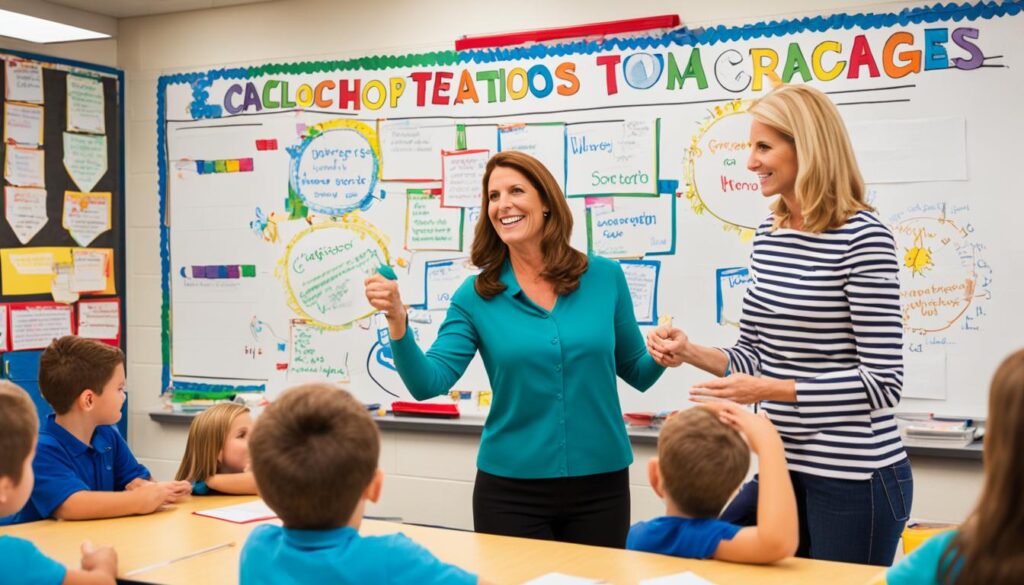Inspire Success: Set Your Teacher Goals Today!

As educators, setting goals is not only beneficial for our students but also for our own professional development and career advancement. It’s time to take a moment and reflect on our educational aspirations, personal growth, and achievement objectives. Are you ready to elevate your teaching career and make a meaningful difference in the lives of your students?
Key Takeaways:
- Setting teacher goals is crucial for professional growth and student achievement
- By organizing your classroom, setting expectations, and improving skills, you can create a positive learning environment
- Collaborating with other teachers and prioritizing self-care through mindfulness are important aspects of setting teacher goals
- Setting SMART goals and continuously striving for improvement can help you achieve academic targets and instructional aims
- By fostering a love of reading, you can inspire your students and enhance their literacy skills
Get Organized for Success
Organizing your classroom and teaching materials is essential for effective classroom management and a productive learning environment. By implementing organizational strategies and utilizing helpful tools, such as file organizers and storage bins, you can streamline your workflow, reduce stress, and create an environment that fosters student success.
One useful tool for keeping your paperwork in order is a file organizer. This handy accessory allows you to store and categorize important forms, printouts, and student files, ensuring easy access when you need them. With a file organizer, you can eliminate the frustration of misplaced documents and stay organized throughout the school year.

Additionally, utilizing storage bins is an effective way to keep your classroom library books and teaching materials neatly organized. By categorizing books and materials in labeled bins, you can easily locate resources for different subjects and activities. This not only saves time but also creates a visually appealing and orderly learning environment for your students.
Create a Classroom Organization System
To establish an efficient organizational system, consider implementing the following steps:
- Assess your current organizational needs and identify areas that require improvement. This may include classroom supplies, teaching materials, student work, or administrative documents.
- Invest in the necessary organizational tools, such as file organizers, storage bins, labels, and shelves. These tools will help you categorize and store items in a systematic manner.
- Develop a labeling system to ensure easy identification of materials. Use clear and concise labels on bins, shelves, and folders to indicate the contents, making it convenient for both you and your students to locate materials.
- Regularly declutter and reorganize your space. Establish a routine for tidying up your classroom and discarding unnecessary items.
Benefits of Classroom Organization
The benefits of an organized classroom extend beyond just aesthetics:
- Enhanced classroom management: An organized environment helps minimize distractions and promotes a smooth flow of daily activities, allowing you to focus more on teaching and less on finding materials.
- Time-saving: Having a designated place for everything saves valuable instructional time and reduces the need to search for teaching materials or supplies.
- Promotes student independence: An organized classroom empowers students to take responsibility for their own learning by easily accessing materials and resources.
- Creates a positive learning environment: A neat and organized classroom inspires a sense of calm, reduces stress, and promotes a positive atmosphere for learning.
By prioritizing organization in your classroom, you can enhance your teaching effectiveness, reduce stress, and create a conducive environment where students can thrive and succeed.
| Benefits of Classroom Organization | Examples |
|---|---|
| Enhanced classroom management | Minimized distractions, smooth flow of activities |
| Time-saving | Easy access to teaching materials and supplies |
| Promotes student independence | Students can find resources without assistance |
| Creates a positive learning environment | Calm and organized atmosphere |
Set New Expectations with Your Students
Engage your students in setting new classroom expectations for the new year. By involving your students in the goal-setting process, you create a sense of ownership and motivation in achieving their goals. This collaborative approach not only empowers students but also fosters a positive and inclusive learning environment.
Brainstorm and Discuss
Gather your students together and encourage them to share their ideas on what they believe the classroom expectations should be. Create an open and respectful space where all suggestions are welcomed and valued. Allow students to express their thoughts and contribute to the discussion.
Example:
| Student Ideas for Classroom Expectations |
|---|
| 1. Respect each other’s opinions and ideas |
| 2. Be mindful of our words and actions |
| 3. Listen actively during class discussions |
| 4. Submit assignments on time |
Finalize and Display
Review the brainstormed ideas as a class, discuss the importance of each expectation, and work together to finalize the classroom resolutions. Make sure the expectations are clear, achievable, and aligned with the overall goals of the class.
Example:
| Finalized Classroom Resolutions |
|---|
| 1. Respect each other’s opinions and ideas |
| 2. Be mindful of our words and actions |
| 3. Actively participate in class discussions |
| 4. Submit assignments on time |
Hang the classroom resolutions in a prominent place where students can easily see them, such as the front of the class or a designated bulletin board. This serves as a visual reminder of the shared expectations and reinforces their importance throughout the year.
Track Progress and Hold Students Accountable
Regularly review the classroom resolutions with your students to track their progress and hold them accountable. Celebrate achievements and provide support when needed. This ongoing reflection and feedback process will help students understand the importance of their commitments and stay motivated to achieve their goals.

Involving your students in goal-setting and creating a positive classroom culture sets the foundation for a successful year of learning and growth. Empower your students to take ownership of their education and watch them thrive!
Continuously Improve Your Skills
As teachers, learning is a lifelong pursuit. To stay ahead in the ever-evolving field of education and drive student achievement, it’s essential to continuously improve your skills. By utilizing professional resources and educational materials created by expert educators, you can refresh and renew your teaching toolkit.
One valuable resource is subscribing to a teacher newsletter. These newsletters provide you with regular updates, teaching ideas, and classroom activities directly in your inbox. Stay informed about the latest teaching trends, innovative strategies, and proven techniques to enhance your classroom practices.
When it comes to learning resources, seek out high-quality materials that are designed to support professional growth. These resources often cover a wide range of topics, from curriculum development and instructional strategies to classroom management and student engagement. Take advantage of online platforms, educational publishers, and professional development programs that offer comprehensive resources to help you gain the knowledge and skills you need to excel as an educator.
By investing time and effort in continuous professional development, you not only enhance your own abilities but also provide your students with the highest quality education. Keep up with the latest research, best practices, and innovative approaches to teaching to create enriching learning experiences for your students.
Benefits of Continuous Professional Development:
- Enhanced teaching techniques and instructional methods
- Increased confidence and job satisfaction
- Expanded knowledge and expertise in your subject area
- Improved student engagement and achievement
- Access to the latest educational resources and tools
- Opportunities for networking and collaboration with fellow educators

| Professional Resource | Description | Benefits |
|---|---|---|
| Online Courses | Interactive and self-paced courses covering various educational topics. |
|
| Educational Conferences | Gatherings of educators featuring keynote speakers, workshops, and networking opportunities. |
|
| Teaching Books | Books written by experienced educators offering insights and practical strategies for teaching. |
|
| Online Communities | Virtual platforms where educators can connect, share resources, and seek advice. |
|
Inspire a Love of Reading
Foster a love of reading among your students by incorporating fun and interactive reading activities. Creating a positive reading culture in your classroom can have a lasting impact on your students’ literacy skills and overall love for books. One effective way to engage your students in reading is through read-aloud sessions.

Read-aloud sessions allow students to experience the joy of storytelling and develop their listening and comprehension skills. Choose a variety of engaging and age-appropriate books to captivate your students’ attention. By infusing enthusiasm and expressive reading into these sessions, you can make the stories come alive and create lasting memories.
Another creative idea to inspire your students’ love for reading is to create a Mystery Book Box. Fill the box with a diverse selection of read-aloud titles, wrapped with intriguing covers. Let your students take turns selecting a mystery book from the box and enjoy the surprise and anticipation as they unwrap and discover the stories within.
To further encourage reading, introduce your students to different genres and styles of literature. By exposing them to a wide range of literary works, you can help them develop their reading preferences and explore new worlds through books. Consider creating a reading challenge or incentive program to motivate your students and reward their reading progress.
The key to fostering a reading culture in your classroom is to make reading a fun and enjoyable experience. Incorporate activities such as book discussions, book clubs, or even themed book character dress-up days to make reading more interactive and engaging. By celebrating the joy of reading, you can ignite a lifelong passion for books and literacy in your students.
Remember, as an educator, you have the power to shape your students’ reading habits and instill a love for books that will benefit them far beyond the classroom. Cultivating a positive reading culture can contribute to their academic success, critical thinking skills, and overall personal development. So, dive into the world of books with your students and embark on an exciting reading journey together!
Collaborate with Fellow Teachers
Collaboration is key in the teaching profession. By dedicating time to collaborate with fellow teachers, you can tap into a wealth of knowledge, experiences, and ideas, propelling your teaching practice to new heights.
One way to collaborate is by serving as a mentor or seeking a mentor if you are newer to the profession. Mentoring provides an opportunity for both mentor and mentee to learn and grow, fostering a strong professional support network that can offer guidance, feedback, and encouragement.
Regularly connect with your fellow teachers to discuss teaching strategies, share valuable resources, and gain fresh perspectives. This collaboration not only exposes you to new ideas but also offers a platform for brainstorming and problem-solving. Together, you can overcome obstacles and find innovative solutions to improve student learning outcomes.
Building a strong teaching community is essential for professional growth and development. By actively participating in collaboration, you contribute to a vibrant and supportive teaching community where everyone benefits from the exchange of knowledge and expertise.
Remember, collaboration is not limited to physical meetings. Online platforms, such as teaching forums and social media groups, provide opportunities to connect with educators from around the world, expanding your professional network and opening doors to diverse perspectives and experiences.
Benefits of Collaboration:
- Access to a wider range of teaching strategies and resources
- Opportunity for peer feedback and support
- Exposure to different teaching styles and perspectives
- Expanded professional network
- Enhanced problem-solving and critical thinking skills
Collaborative Activities
| Collaborative Activity | Description |
|---|---|
| Lesson Planning Together | Collaborate with fellow teachers to create engaging and effective lesson plans that cater to diverse learning needs. |
| Peer Observation | Participate in peer observation sessions to observe and learn from colleagues’ teaching practices. |
| Co-Teaching | Team up with another teacher to deliver lessons together, providing students with varied perspectives and support. |
| Professional Development Workshops | Organize workshops or participate in professional development sessions to learn from experts and share insights with colleagues. |
| Online Collaboration | Join online teaching communities and engage in discussions, sharing ideas and resources with educators worldwide. |
Collaborating with fellow teachers is an enriching experience that fosters professional growth, supports new ideas, and strengthens the teaching community. Take advantage of the benefits collaboration brings and create a network of support that propels your teaching career forward.
Prioritize Self-Care and Mindfulness
Taking care of yourself is essential as a teacher. In the midst of your busy schedule and the demands of your profession, it’s crucial to prioritize self-care and mindfulness to maintain your overall well-being and reduce stress. By incorporating simple yet effective mindfulness practices into your daily routine, you can cultivate a sense of calm and enhance your mental health.
One way to practice mindfulness is to focus on your breathing. Take a few moments throughout the day to pause and pay attention to your breath. Close your eyes, inhale deeply through your nose, and exhale slowly through your mouth. This mindful breathing exercise can help center your thoughts and bring a sense of relaxation.
Another effective method of self-care is to take regular breaks. Throughout the day, allow yourself short periods of time to step away from your work and engage in activities that bring you joy. Whether it’s taking a stroll outside, listening to music, or practicing a hobby, these rejuvenating moments can help refresh your mind and recharge your energy.
In addition to breathing exercises and breaks, incorporating meditation into your routine can also promote well-being and reduce stress. Find a quiet space, sit comfortably, and focus your attention on your breath or a specific point of focus. Allow any thoughts that arise to pass by without judgment, returning your attention to the present moment. Even spending just a few minutes a day in meditation can have a significant impact on your mental clarity and overall stress reduction.
Remember, prioritizing self-care and mindfulness is not a luxury but a necessity. By taking care of your own well-being, you can better support your students and create a positive teaching environment. Embrace the power of self-care and mindfulness to enhance your overall well-being and cultivate a stronger connection with yourself and those around you.
| Benefits of Self-Care and Mindfulness | Strategies to Incorporate Self-Care and Mindfulness |
|---|---|
| 1. Reduces stress and anxiety | 1. Practice mindful breathing exercises |
| 2. Improves mental clarity | 2. Take regular breaks to engage in activities you enjoy |
| 3. Enhances overall well-being | 3. Incorporate meditation into your daily routine |
| 4. Cultivates a sense of calm and relaxation | 4. Create a self-care routine that suits your needs |
Conclusion
Setting teacher goals is the key to unlocking your professional growth and fostering student achievement. By organizing your classroom, setting clear expectations, continuously improving your skills, and nurturing a love of reading, you can create an impactful learning environment that inspires success. Collaboration with your fellow teachers, prioritizing self-care and mindfulness, and modeling kindness are vital elements of setting and achieving your teacher goals. Remember to set SMART goals, and with dedication and perseverance, you can make a lasting difference in the lives of your students.
As educators, your aspirations to excel in your teaching career and drive student success are commendable. By getting organized, you can streamline your teaching materials and create a more efficient and effective classroom. Setting expectations with your students empowers them to take ownership of their learning journey and work towards their academic and personal goals. Continuously improving your skills through professional resources and upskilling opportunities will enhance your teaching toolkit and enable you to better support student achievement.
Fostering a love of reading is a powerful way to empower your students and instill a lifelong passion for learning. By incorporating fun and interactive reading activities, creating a reading-centric environment, and providing diverse literary experiences, you can inspire students to become avid readers. Collaboration with fellow teachers offers valuable insights, support, and fresh ideas that can enhance your teaching approach. By prioritizing self-care and mindfulness, you can maintain your well-being, reduce stress, and be a positive role model for your students. Your dedication to setting and achieving teacher goals will pave the way for both personal and professional growth.






